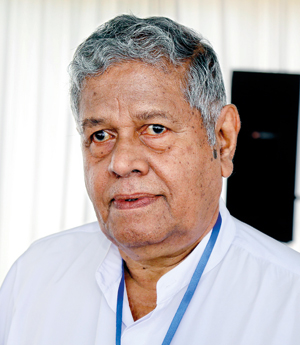Retracing a lost empire’s links to Ayurveda medicine

Prof. Suriya Gunasekera
Professor Suriya Gunasekera set himself an arcane quest after retiring from the Sri Lankan Administrative Service. His initial hunt to establish the authenticity of the Ravana legend would lead him to Atlantis, Lemuria, old Mu and Egypt, and finally to the portal of the lost Hela Empire- a Sinhalese superpower that claimed the entire tropical world for itself- from the rocky Andes to the aquamarine Fiji.
At the Siddhalepa International Ayurveda Symposium, held at the breezy Siddhalepa Ayurveda Resort in Wadduwa last Saturday and Sunday (October 5-6) the retired civil servant captured a diverse audience with what to him has been a happy obsession, conquering a whole library and tables groaning with musty books at his home in Kotte.
Dr. Gunasekera began as a D.R.O and was an Additional Ministry Secretary when retiring. His PhD thesis was on the hydraulic civilization of ancient Ceylon.
At the symposium his subject was Hela Osu and deshiya chikitsa- native Sinhalese medicine and surgery, but it is all thickly embedded in a lost world- whose vestiges- he claims- lie amidst corals- in skeletal splendour within the Indian, Atlantic and Pacific oceans.
The Hela or Sinhalese Empire, conquering the tropics in its entirety, was one which looked to the sun as god and benefactor. Cultures that sprang up following the Hela culture in South America and Egypt, with atavistic memory, built temples to the sun and even enacted bloody sacrifices to ensure the fiery god’s return, day after day.
All the rulers of the Hela Empire were sages not kings- and their rule concerned the spirit rather than the body. The Hela osu or Sinhalese medicine was first found by these sages or rishis- one of the oldest of whom was Pulasthi, grandfather of Ravana. It was he who developed the system of va pith sem- checking the wellness of a person through the air, heat and liquidity present in him.
The native medicine man can measure these simply by reading the pulse of the patient- in the method discovered by Pulasthi’s grandson Ravana.
The Veda mahattaya’s task then is to prescribe the medicine that has been written down in kavi (Sinhala verse) by the ancient sages.
Early sages, says Dr. Gunasekera, identified herbs not through trial and error ‘lab’ experimenting, but through vingyana- sending the spirit away from the body via meditation.
Plants absorb carbon dioxide and therefore produce minerals- a feat impossible for humans. The basic premise in Sinhalese medicine thus is to provide the body whatever it is lacking by imbibing natural plants- purely an interaction between human and herb.
Yet medicine was only one of the fields included under Hela education. Though one pundit usually specialized in one area, Ravana was master of ten subjects- the reason why he is called ‘dasis’ or ten headed- totally lost on the Indian sculptor who equipped the sage with ten demoniac visages.
India despite its subcontinental mass, claim the ‘Hela-ists’, was a backwater compared to Sri Lanka- a claim that is lent credence by the 2nd Century world map drawn by Ptolemy- where Taprobane is 14 times its actual size while India is small, possessing only a flat snout for a peninsula.
The deva education system of the Sinhalese had its main institution at Bhrigu Kachcha (now Broach) on the Eastern coast of India- for at the time many parts of India- including Orissa, Gujarat and Hyderabad, were Sinhalese outposts.
The last chancellor or ‘sakra’ of Bhrigu Kachcha was Sumana Saman. This was at the period of the Buddha’s visit to Ceylon. The Buddha’s teachings did not approve the use of meditation for worldly ends (but only to attain Nirvana) and so Sumana Saman, after becoming a Buddhist, decided to do away with the entire tradition of education (which used meditation or worldly ends), which then, with its roots wrangled off, planted itself in India. There, medicine became ‘Ayurveda’ and the ahas satara or ‘sky science’ became Indian astrology.
But the saga of Serendib as a superpower does not peter out there. There is a footnote that Dr. Gunasekera adds with hope and a wry smile for good measure.
Helena Petrovna Blavatsky, the occultist made a prediction in the 19th Century, that the sixth root race or super power will start to emerge from America in the 21st Century- which in Victorian times was not as obvious as it sounds today.
Her candidate for the seventh is supposed to spring- according to some- from Ceylon.
It is easy to scoff but much harder to deny outright such esoterica. There are the seven old medical treatises- including nadi shastra and rasa vedakama- written by Ravana with their wisdom, and a landscape that has been touched, and remembers via toponymy the poetry of Ramayan.
The Siddhalepa Ayurveda Symposium had for its raison d’être bringing to the global limelight this ancient form of medicine. It could be a first step to reclaim something of the aureole of glory that was, perhaps, once ours.


